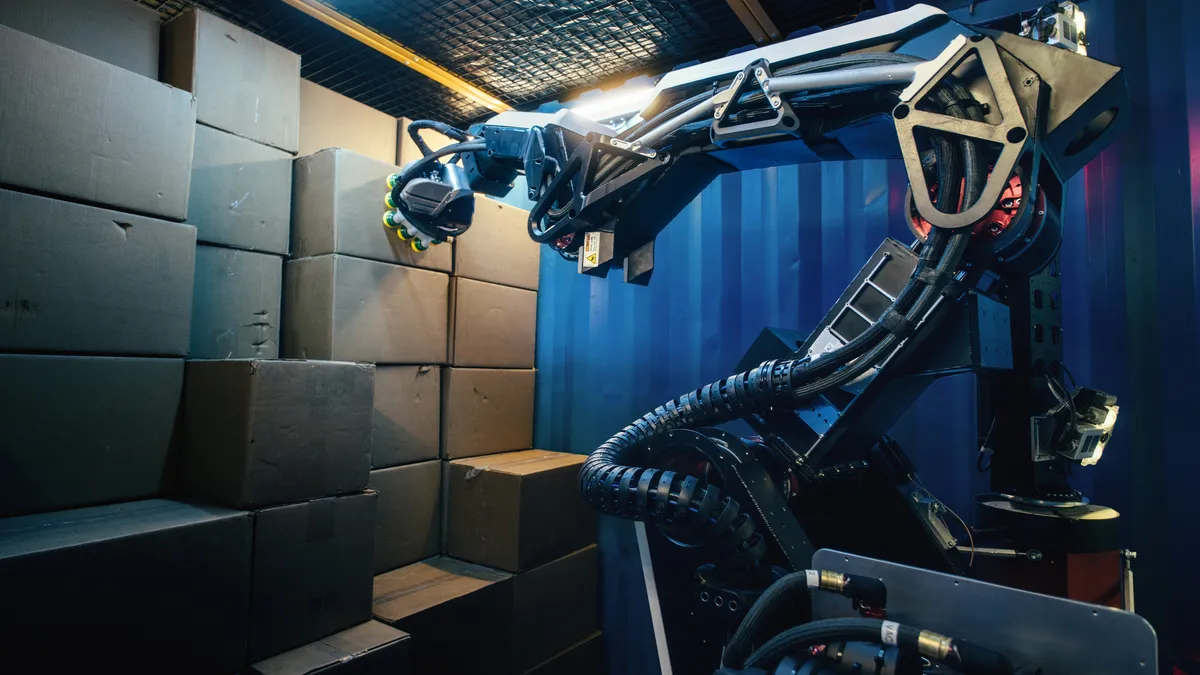Dive Brief:
- Boston Dynamics has rolled out its new warehouse robot, Stretch, with "a shortlist of early adopters," and the company is actively looking to add companies to pilot its technology, Brian Nachtigall, the logistics project manager on the Stretch project, said in an interview with Supply Chain Dive last week. The company could not discuss who the early adopters are, but it plans to have companies in retail, third party logistics and product manufacturing, Nachtigall said.
- The material handling robot is expected to have a pick rate of 800 cases per hour, lift up to 50 pounds and is expected to have a battery life of eight hours, according to a spec sheet provided by the company.
- "We're focusing on truck unloading first and we will, over time, be developing additional applications," Nachtigall said.
Dive Insight:
The technology company that is famous for the viral videos of its robots dancing and completing impressive acrobatic feats is working its way into the warehouse market that has become increasingly automated in recent years.
Stretch is not the first warehouse robot that Boston Dynamic has released footage of. In 2017, it announced Handle and showed it being used for logistics applications in 2019.
Videos of Stretch provided by Boston Dynamics show the mobile robot pulling a conveyor belt into a trailer stacked with boxes. It then begins to pull boxes and place them on the conveyor to be moved into the warehouse. When the boxes are gone, it rolls the conveyor out of the now empty trailer.
Boston Dynamics is not the first company to tackle autonomous truck unloading. Honeywell announced its robotic truck unloader in 2019. And Honeywell says it has seen increased demand for the product as a result of the pandemic, the company said last year.
"A lot of our customers will put multiple people into these trucks to help unload," Matt Wicks, former chief robotics solution architect at Honeywell Intelligrated, told Supply Chain Dive in an interview last year. "And so now, with social distancing, there's a reduction in the number of people and therefore a reduction in the throughput."
Boston Dynamics expects its robot to be about as fast as manual operations, Nachtigall said.
Details from the company show that it can be chared with a universal AC input, but it also says there is the option of a fast-charging station. Alternatively, it can connect to a power source instead of running on battery for continuous option.
"Unloading trucks is one of the least attractive jobs in a warehouse," he said. "And being able to take on that kind of work is something that a lot of warehouse operators are very interested in being able to automate."
Truck unloading is one of the easier processes in the warehouse to automate, he said. But Boston Dynamics envisions Stretch being used for other applications in the warehouse over time.
"On the other end of the spectrum is this order-building activity of working through a warehouse, picking, picking from same-SKU pallets in a rack, and building multi-SKU pallets," he said, noting that the company is currently working toward this capability.
Order picking will require integration with a facility's WMS, which unloading does not need. And it will involve more localization with the robot being able to understand where in the facility it is in relation to the next order.
"There's a few additional pieces of the puzzle to that full order building activity," Nachtigall said. "Starting with truck unloading essentially simplifies that initial problem and allows us to build the functionality as we go."
Boston Dynamics says that putting the robot in place for truck unloading is a pretty low lift in terms of infrastructure requirements.
"The goal is to be able to have a mobile robot that we can work with the customer to identify their application, identify the facility — initially going to be truck unloading — and we'll identify which dock doors they'd like to install the modules and we can go and have the robots up and running relatively quickly," Nachtigall said.
Boston Dynamics plans to commercially release Stretch sometime in 2022, according to a press release from the company.
This story was first published in our weekly newsletter, Supply Chain Dive: Operations. Sign up here.















